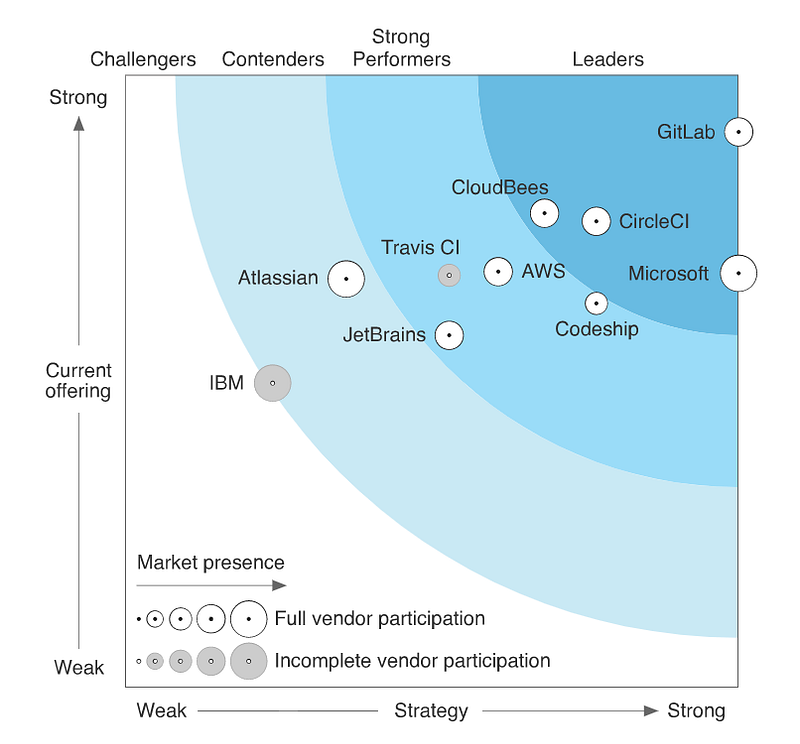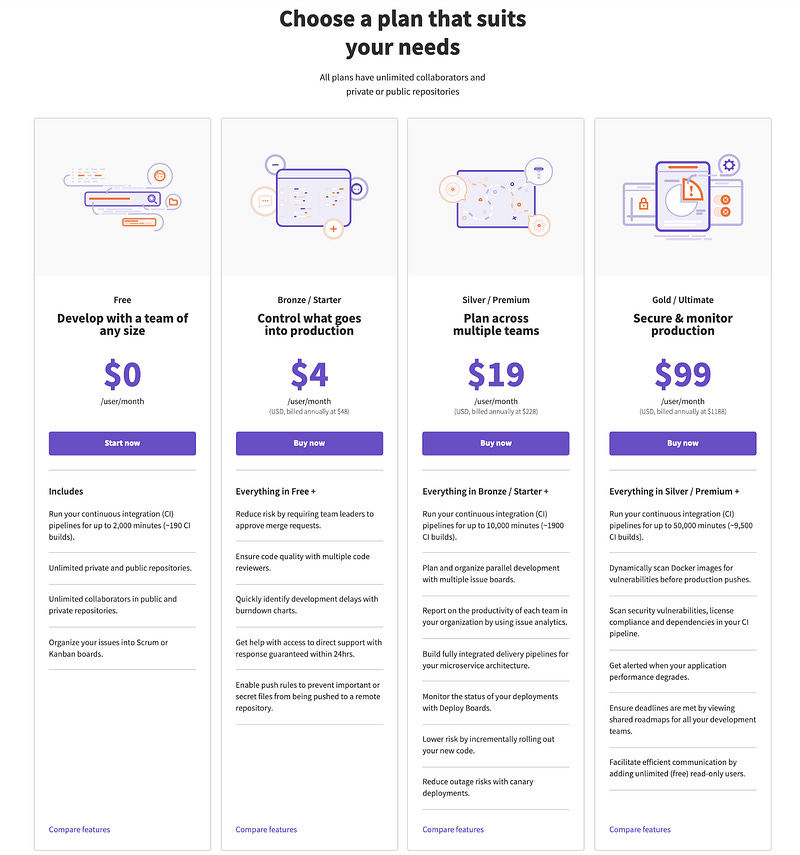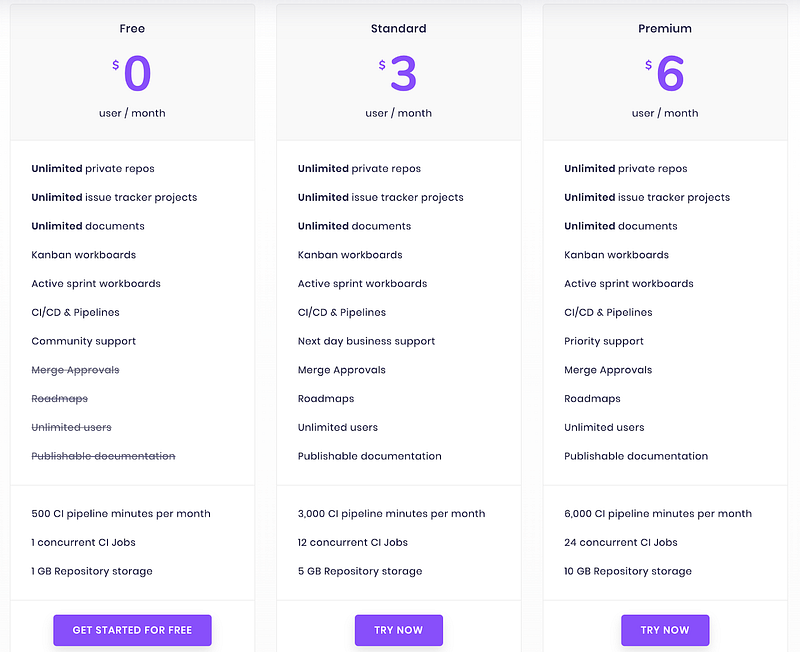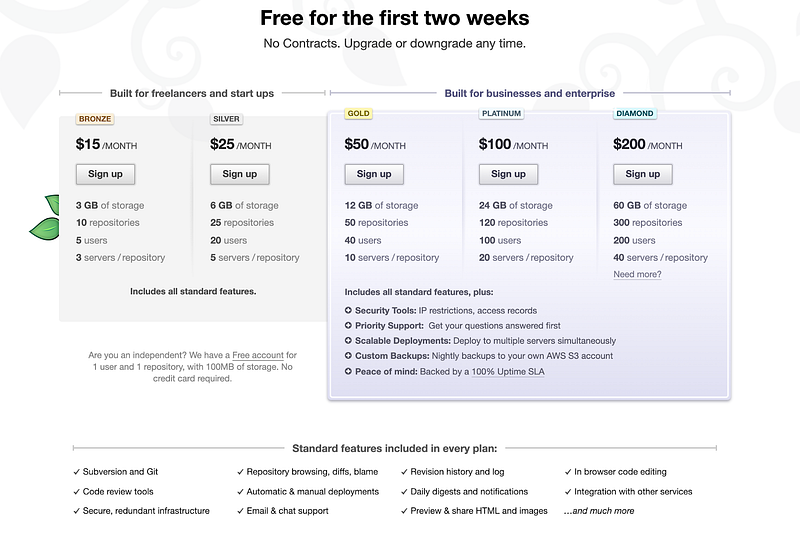Top 13 GitHub Alternatives in 2020 [Free and Paid]
If you are looking for a reliable yet powerful GitHub alternative, this article unveils some of the best alternatives to GitHub you can…
If the black cat doesn’t seem cute enough, and you are looking for a reliable yet powerful GitHub alternative, this article unveils some of the top GitHub alternatives you can find today.
Every tool on this list is discussed in detail to help you make a better decision whether to switch over to another git platform or stick with GitHub.
We’ll start off with GitHub’s description and then hop off to its best alternatives.
Without further ado:
GitHub
GitHub is a closed-core platform that hosts open-source software and projects. It’s also perhaps the most popular tool for developers today. It maintains one of the best free version control software today — git. You can find some of the best open-source projects in GitHub. Even if you are a beginner, you can find great open source projects to contribute to. You can download either a GitHub Mac or Windows version.
GitHub Project Management
GitHub comes with an Issue Tracker where you can create cards, add notes, assign tasks to your team members, and track your projects effortlessly. Creating task descriptions and commenting on assignments in GitHub feels like a breeze. You’ll also have the ability to reorder and structure your tasks so that no frustration comes along your way.
You can add milestones to your projects and set weekly, monthly, or quarterly goals and thus better track your team progress.
You can also link issues to your pull requests to simplify your workflow. Issues linked to pull requests will automatically close when the pull requests merge.
You can assign up to 10 team members to an issue. People who have access to your projects will be instantly notified via email or slack when changes occur. Comment notifications are also included — you can set it up easily.
Labeling your tasks and pull requests definitely pays off in the long term. When searching for an issue, labels allow you to find the thing you are searching for at a cat’s speed.
GitHub also boasts integrations with great tools like Google, Codacy, Code Climate, etc.
Pull and Merge Requests
You can use pull and merge requests to peer review and enhance the quality of your code.
Identify code differences, add comments, and provide more transparent and structured feedback easily. And thus develop better features. You can invite your team members to GitHub by sharing your GitHub code repository.
You can read through your commits, comments, and references located inside the pull request in a timeline-style interface that doesn’t overwhelm you with an excessive amount of features.
By using side-by-side diffs, you’ll have the chance to easily comprehend the “before-and-after” state of your code so you can better understand mistakes you should avoid in your future builds.
GitHub also boasts a blave view allowing you to see the evolution of a portion of a file over time without browsing the file’s entire history.
GitHub Actions
With GitHub Actions, you’ll have the opportunity to immensely simplify your workflow by having everything you need to go from development to deployment in one place. You can build, test, and deploy your code inside GitHub — no 3rd party apps required to sustain your development life cycle. No multiple jaw-dropping billings to stare at the end of each month.
GitHub Actions runs on every major OS. It can also be powered on a VM or inside a container. Whether you are using your own VMs in the cloud or on-premises, GitHub Actions runs smoothly.
What’s cool, GitHub Actions comes with matrix workflows that can run tests simultaneously across various OSes.
GitHub Actions supports Node.js, Python, Java, Ruby, PHP, Go, Rust, .NET, and a few other languages.
You can use live logs to see how your builds perform in real-time through colors and emoji.
More Features
Permissions
In GitHub, you can use permissions to give as much repository access as you want to your teammates. If you wish to grant your whole team or just a few team members with read or write repository access, GitHub makes it easy. Keep in mind that permissions vary based on pricing plans.
Protected branches
With Protected Branches you’ll have the chance to maintain the integrity of your code, meaning you can define who will push to the branch. And scale your policies with the Protected Branches API.
Required status checks
Add extra layers of security to your branches by creating required status checks. You can use the Status API to empower checks and disable the merge button until they pass.
Security — Eradicate vulnerabilities
Add extra layers of security to your DevOps cycle — Find and eliminate all possible vulnerabilities. With GitHub Advanced Security, you can scan across multiple codebases at scale. By building on existing queries and automating variant analysis, your team can discover and eliminate significant vulnerabilities much quicker, even in the largest codebases.
Pricing
You can take a look at the pricing plans below (You can self host GitHub Enterprise and GitHub One):
By the way, it’s worth noting that GitHub now offers free private and public git code repositories on their free plan. And you can also have unlimited members on board, at no cost. You can host your local GitHub repositories without any hassle.
GitHub Pros and Cons
Pros:
It’s super simple and easy to use. Boasts tons of integrations with other great tools. And it has everything you need to go from development to deployment in one place. You can rest assured that GitHub won’t overwhelm you with a chaotic interface or features thrown all over your screen, leaving you angrily flushed and clueless about how to deal with it.
GitHub brings a huge store of products you can explore and fit into your workflow to make your work life easier. You should definitely check it out.
You can host your documentation directly from your repositories for free with GitHub Pages.
Also, GitHub servers are quite stable, and you’ll rarely, if ever, experience any downtimes.
Cons:
It can be quite pricey compared to other tools.
Visual charts can be hard to comprehend.
History tends to get polluted, and it becomes quite challenging to find the thing you are searching for.
Also, GitHub’s storage limit on the free plan can be a bit low.
Github doesn’t provide you with thoroughly-explained documents on importing or exporting. It can be hard for you and your team to comprehend the import/export process.
Yet it comes with a tool called — Github importer. What’s cool about it is that it automates the whole importing process for you. So importing to GitHub is easy, but exporting stuff from GitHub can be a tedious task.
Alright, let’s now explore the top GitHub competitors and alternatives…
GitLab
GitLab, the first free alternative to GitHub that comes to mind, boasts all the tools for a complete DevOps lifecycle.
It’s one of the best git clients out there as it provides you with everything from project planning to deployment. GitLab spurs your team with robust features to help you accelerate your DevOps life cycle. The software is used by more than 100,000 organizations globally, including NASA, Goldman Sachs, Sony, EA, and other big brands and companies.
Issue Tracker (GitLab Issues):
Inside GitLab Issues, you can note everything down and avoid getting issues or tasks lost in email or chat. You can thus precisely plan future tasks and ensure that project execution is flawless. Use tags and comments to ensure a smooth team collaboration.
Similar to GitHub, here, you can also label your tasks and issues. You can categorize your tasks into different stages like “to-do,” “in progress,” and “done” to keep a clear track of the team’s progress. Moreover, GitLab boasts GitLab boards (visual management of your projects). GitLab boards empower you with great visibility over your projects so you can clearly see the direction your project is moving towards. Epics and roadmaps are included in the package.
GitLab also makes the migration process very easy. It has thorough documentation about importing and exporting data. You can easily migrate from GitHub to GitLab.
Other features:
Issue boards: Structure your tasks the way you like it.
Epics: With epics, you’ll have the chance to track your progress effortlessly and, at the same time, make better project-related decisions.
Roadmaps: Roadmaps help you visualize your project’s steps over the long term. And thus help your team clearly see the next steps they need to take to finish the project successfully while meeting every deadline.
Burndown Chart: When you need an efficient way to track your team’s progress, your №1 option is burndown charts. Burndown charts are great as they allow you to easily see the progress that is being made. They also enable you to see potential impediments that may hamper your workflow in the future.
Points and Estimation: You can assign weight attributes to your issues. And thus see the estimated effort that is needed to complete a particular task.
Traceability: Link your issues with merge requests and track your project’s progress from beginning to end.
Wikis: Put your docs and code in the same place.
GitLab CI:
GitLab is designed with perhaps the №1 built-in CI/CD tool out there. In fact, GitLab’s CI/CD is the main reason why tons of developers switch over to GitLab (It was the primary difference between GitHub and GitLab in the past… and it can still be).
Before GitHub Actions occurred, GitHub didn’t provide a built-in CI/CD, and developers had to integrate with Jenkins or another CI/CD platform. GitLab could spare all the struggle with configuring a 3rd party CI/CD by bringing everything in one place.
GitLab CI will help you accelerate your dev process and empower you to release brand new features faster than you ever did before.
CI/CD Features:
Open source: You can get access to GitLab CI in the Community Edition and the proprietary GitLab Enterprise Edition.
Easy to learn: Check GitLab’s Quick Start Guide.
Scalable: The CI tests are run on separate machines. You can stack as many as you want and scale enormously.
Faster results: You can speed up the development process by splitting your code builds in multiple jobs that can run in parallel on various machines.
Optimized for delivery: multiple stages, manual deploy gates, environments, and variables.
Source Code Management:
Collaborate
Use merge requests to review your teammates’ code or get your build peer-reviewed inside your source code repository, thus enhancing the quality of the features you release.
You can also utilize code reviews for text instead of code. Using the code review features to review text will allow you to track versions, changes, document proposals, and approvals.
GitLab boasts an easy-to-use Web IDE. You can avoid switching between multiple browsers and ease your workflow by using GitLab’s intuitive Web IDE.
Compliant and Secure
With GitLab, you can automatically scan your code and eliminate potential vulnerabilities to ensure everything runs smoothly.
You can also simplify auditing and compliance with granular access controls and reporting.
DevSecOps:
Keep a piece of mind with GitLab’s DevSecOps.
Static Application Security Testing (SAST): Catches and stops vulnerabilities early in the development cycle.
Dynamic Application Security Testing (DAST): Keeps your deployed build safe from any possible attacks as you are running your web applications.
Dependency Scanning: Scans your dependencies in attempts to find any potential security vulnerabilities while you are developing and testing your applications.
Container Scanning: Analyze your container images for vulnerabilities.
Other GitLab features:
With GitLab, you can give repository access to a person based on their job title.
GitLab comes with multiple integrations, LDAP group sync filters, SAML SSO for groups, and LDAP support.
You’ll also get access to smart card support, value stream management, and IP whistling for authentication.
You can compare the pricing plans in the image below:
You can also self host GitLab and deploy your GitLab instances on-premises or in the cloud.
In the past, GitLab used to outweigh GitHub in any possible way when it came down to features. However, with the release of GitHub Actions, free GitHub private repositories, and GitHub codespaces, the “GitLab vs GitHub” scales stand equal now. The GitHub Team plan can compete very well against the GitLab starter plan.
GitLab is definitely one of the top 3 GitHub alternatives. It can take care of your entire development cycle. Feel free to check it out.
BitBucket
BitBucket is another fantastic git client and GitHub alternative owned by Atlassian.
BitBucket is used by many big enterprises because it integrates with other Atlassian tools such as Jira, Confluence, and HipChat, making it very easy for big teams to manage their projects. That’s actually one of the main differences between Bitbucket and GitHub, or any other tool. Yet, Bitbucket is a closed core git version control platform that hosts open-source projects, just like GitHub.
You can use BitBucket for free with up to 5 team members on board. You also get unlimited private repositories. You just need to apply for a community license and adhere to Atlassian’s open-source guidelines.
BitBucket Features:
Built-in CI/CD — BitBucket Pipelines, similar to GitLab CI and GitHub Actions, can help you accelerate your dev process. It helps you catch and fix bugs early in the cycle and then deploy swiftly without any hassle.
You can create your own personal source code repository on Bitbucket as well.
Code review — use pull and merge requests to enhance the quality of your code. Release outstanding features to tame the appetite of your customers for brand new features and updates. Code review comments are supported in pull requests.
Security — BitBucket keeps your code secure with IP whitelisting and 2-step verification. You can restrict access to particular users through branch permissions and merge checks. Bitbucket also boasts a SOC 2 Type II certification. You can rest assured that your build will stay intact while being hosted on BitBucket.
JIRA integration — It easily integrates with JIRA (the most popular issue tracker for developers) and Trello. You can sync your pull and merge requests with JIRA issues or Trello cards.
LFS support.
Store large files and rich media in Git LFS (Large File Storage).
Source code search.
Wiki for projects.
BitBucket cloud for hosting static websites.
Smart Mirroring for a faster clone, fetch, pull (only for Premium users).
Bitbucket offers a free plan for up to 5 users.
Check the pricing (Bitbucket vs. GitHub) below:
All in all, Bitbucket is definitely a good option for bigger teams and enterprises. It integrates easily with other Atlassian products making your workflow significantly easier to manage.
Codegiant
Codegiant is a great GitHub alternative that offers a simple issue tracker, built-in CI/CD framework, bug tracking system, source code management, and more importantly, it has quite an intuitive interface.
Like GitLab, it boasts tons of features that can move your project idea to the cloud quite easily. The uniqueness of Codegiant stems from its super simple and intuitive interface.
Issue Tracker
Codegiant’s issue tracker offers both Kanban and Scrum board views.
If you are in a hurry and time is of the essence, the scrum board view will help you structure your workflow in the most efficient way so you can meet all of your deadlines.
Otherwise, you can pick the Kanban board and get a 50,000-foot view of your projects to clearly see the direction your project is moving towards.
Issue Tracker features:
An agile project management software with a simplistic interface.
The issue tracker features two board styles: Kanban and Scrum.
Roadmaps.
Sprints.
Epics.
Analyze your tasks’ performance.
Tasks and subtasks.
Tags, mentions, and comments.
Time estimates.
Codegiant has a free plan for up to 5 users, then starts at $3/user a month.
Repositories & Web IDE
Except for great git repositories, Codegiant also brings a simply-designed Web IDE to the table. You can stop bouncing between various browsers to build your code and instead have everything in one place. You can easily import existing repositories from Github, Bitbucket, hosted Git servers, or SVN to Codegiant.
Merge Requests
With Codegiant, you can use pull and merge requests to get your code peer-reviewed and enhanced to fully delight your customers with high-level features.
Collaboration
Use inline comments, threaded conversations, and mentions to bring your team on the same page and meet every essential deadline frictionlessly. You can also control the access to your repositories to make sure the right people are working on the right things.
Codegiant Flow
An integrated CI/CD tool that allows you to run concurrent jobs. Easily define and orchestrate how job execution (build, test, deploy) is run and automate deployments. Rollback to a previous deployment with one click. And thus spur your team to release features much faster than it did before. Codegiant CI supports native Docker, Kubernetes, and the Knative engine.
Documentation tool
Codegiant also features quite a robust publishable documentation tool. You can create API documentation, status pages, knowledge bases, product roadmaps, etc. You can also upload your logo and press publish. Once published, you instantly start building trust and authority with the visitors that land on your website.
You can check the pricing plans of Codegiant below:
Codegiant is a pleasant-to-the-eye GitHub free alternative. It’s simple and straightforward to use. The onboarding process is significantly shorter than other similar tools. Feel free to check it out.
SourceForge
SourceForge is another big name on this list of GitHub alternatives. It boasts 32 million users. The company is owned by Slashdot Media (top technology community in the world).
SourceForge is quite a simplistic alternative to GitHub. However, it’s not as robust as GitHub is in regards to features. With SourceForge, you can develop and get your code reviewed and also publish open source projects.
Inside SourceForge, you have access to repositories, bug tracking software, mirroring of downloads for load balancing, documentation, mailing lists, support forums, a news bulletin, micro-blog for publishing project updates, and other features. However, there’s no built-in CI/CD on the horizon.
SourceForge is very popular when it comes to open source projects and software. Many Linux projects are developed through SourceForge. After all, it’s completely free.
More features:
Get thorough stats and analytics for your projects to assess your team’s performance. You can also use filters like location, platform, regions, etc. when downloading the reports.
The open source directory enables you to categorize your projects, take quick screenshots, and share your projects easily on social media.
Open-source repositories allow you to host code with Git, Mercurial, or any subversion.
It supports Apache Allura. You can host your forge and initiate further improvements.
SourceForge comes with a GitHub importer that makes the process effortless.
Here’s what other developers have to say about SourceForge:
Launchpad
Launchpad is another great GitHub alternative from Canonica. Launchpad has been primarily used for Ubuntu projects. Although Launchpad has been present for many years, it hasn’t gained the popularity of GitLab, GitHub, BitBucket, etc. Some developers speculate that’s because it’s mainly suited for Ubuntu related projects.
Launchpad Features:
Launchpad comes with an intuitive bug tracker. You can create and share bug reports, statuses, patches, and even comment on issues. You can also share data with other trackers such as Bugzilla and Trac. Some of the features this bug tracker offers are web emails, API interfaces, issue links, and more.
Bug reports are made to be digested easily. Within a glance, you can identify the bugs’ location in the code and jump straight into solving them.
Launchpad boasts comprehensive code reviews. Reviewing code is made more than easy. Diffs are also available so you can see the “before-and-after” state of your code. Threaded discussions are a part of the equation and will help bring your team on the same page.
Team Branches — Everyone from your team has permission to commit to a centrally hosted branch.
Mailing lists are available in each team. They come with simple subscription management, automatic archiving, and are administration-free.
Translations — Launchpad makes translations effortless. You can get your software translated by a community of more than 47,000 people operating in 293 languages.
Code hosting (supports both Git and Bazaar)
Support in your language.
Web services API
Track bugs by email.
Knowledge bases and FAQs.
On the whole, Launchpad is definitely an option to consider if you are looking for a reliable bug tracking system. It boasts tons of features. And you won’t have a hard time managing issues in the bug tracking system.
Google Cloud Source Repositories
With Google Cloud Source Repositories (a fantastic code repository tool), you can get started for free with a limit of 5 users and 50 GB of storage. You get access to a 12-month trial period.
The trial usage is kind of limited, and you might not have the chance to fully experience and try out Google Cloud Source Repositories. Yet, you can always upgrade your plan quite easily. You can learn more about the free tier usage limits here.
Google Cloud Source Repositories boasts built-in CI/CD integrations to help you accelerate your DevOps cycle and thus release new features faster. Setting up triggers to automatically test your code happens quite effortlessly.
Cloud Source Repositories Features:
Deploy directly from Cloud Source Repositories. No need for 3rd party apps.
Build and test your code — Cloud Build empowers you to automatically build and test your build when deployed.
Versioning and aliasing for serverless requests — Track changes to your source code over time.
Debug in production — Google allows you to review your code while it’s in production without hampering the application in any way.
Detailed audit logs — Logs arm you with insights into your repository history so you can clearly see what has changed along the way that brought your repos to their current state.
Integrations — Link your repositories with any other Google product.
You can view all of your repository files using Source Browser. You can target a particular branch, tag, or commit.
Automatic syncing — If you have GitHub or Bitbucket repositories, Google allows you to sync them with your Cloud Source Repositories and get all your files transferred to Google. All automated.
You can rest assured that your code is secure. Your code is run on Google’s high-availability infrastructure, and Google boasts multiple data centers across the globe.
Check the pricing plans below:
All in all, Cloud Source Repositories is great for those searching for a simplistic interface and built-in CI/CD integrations. Give it a try.
AWS CodeCommit
AWS CodeCommit (another code management tool) is a similar alternative to Google Cloud Source Repositories.
AWS CodeCommit’s primary purpose is to ease the collaboration between developers. That’s why committing, branching, and merging your code happens without any hassle whatsoever inside CodeCommit. You can use pull requests to enhance your code and release great features. You can also create repositories from the AWS Management Console, AWS CLI, or AWS SDKs.
AWS also delivers a free tier. It’s free forever if you adhere to the free-plan limits as mentioned in the documentation. Though you can always upgrade your plan and get full access to all AWS CodeCommit features.
Your free plan includes 5 users and 50 GB of storage. Adding more users is priced at $1 per every additional user.
You also get unlimited repositories on your free plan. You’re first granted 1,000 repos by default, but you can request as much as you want without limits.
AWS CodeCommit Features:
Encryption
You can transfer files from and to CodeCommit using SSH or HTTPS easily. The AWS KMS (Key Management Service) automatically encrypts your repos using customer-specific keys.
Access Control
You can regulate other people’s access to your repositories through AWS Identity and Access Management. Monitoring your repositories can be done through AWS CloudTrail and CloudWatch.
High Availability and Durability
You can rest assured that your repos stay secure as CodeCommit stores them in Amazon S3 and DynamoDB servers. Amazons’ architecture is notorious for increasing the availability and durability of your repository data. Your encrypted data is stored across multiple facilities so that you can get a piece of mind.
Easy Access and Integration
AWS CodeCommit easily integrates with other Amazon products like AWS Management Console, AWS CLI, AWS SDKs to make managing your repositories a pleasant experience instead of a dreary endeavor. CodeCommit supports every git command and works with your existing git tools smoothly.
Notifications and Custom Scripts
Notifications, related to changes in your repos, will appear as Amazon SNS notifications. These notifications are quite robust by themselves. Each one comes with a status message and a link pointing to the event that initiated the notification.
Here’s a great comparison table (GitHub vs. CodeCommit) by Artur Yolchyan, an expert software developer running the Code Skills blog.
AWS CodeCommit vs GitHub
Here’s what other developers have to say about CodeCommit.
Gogs (Self-Hosted)
Gogs is an entirely self-hosted solution to host your code. It’s easy to install. All you need to do is run the binary for your platform. Or ship Gogs with Docker or Vagrant, or get it packaged.
Gogs runs on Windows, Mac, Linux, ARM, etc. Pretty much anywhere where Go can compile for.
Also, it is a very lightweight option that can run on a Raspberry Pi.
Gogs came to the world years ago. It was managed by a single person who regularly disappeared without fixing any problems or merging for weeks. So, Gogs got forked by a group of contributors (and thus, Gitea appeared). As a result, Gogs was actually pushed into more active development. Even though Gogs and Gitea are quite similar, they have major differences like OAuth support. Gogs is also more robust in features but it has a slower release cadence.
Features:
It’s a GitHub clone. The difference between GitHub vs Gogs is that Gogs tends to be easier to use. Yet, GitHub comes with incredible features and it’s home to more than 50 million developers.
An issue tracker is available.
Easy setup from binary.
You can ship it with docker, vagrant, or as a package.
Great support.
It’s a very lightweight and easy-to-use alternative to GitHub (it runs on Raspberry Pi)
Wiki & docs.
If you are looking for quite a simplistic alternative to GitHub that empowers you to manage your repos easily, then Gogs can be a suitable option for you. On Gogs’ website, you’ll find robust documentation on getting on board. Overall, it’s an easy-to-use platform for managing your code.
Gitea
Gitea is a lightweight GitHub clone (forked from Gogs) written in Go lang.
Similar to Gogs, it runs on Windows, Mac OS, Linux, ARM, etc. Gitea is a super lightweight alternative to GitHub. It’s intuitive and an easy to use platform that makes managing your code a breeze. Gitea has low minimal requirements and can run on an inexpensive Raspberry Pi. It’s an open source platform and everyone can contribute.
Gitea boasts an issue tracking system that allows you to add milestones, labels, and time tracking. Gitea’s issue tracker is a simplistic alternative for other complex and sophisticated options.
You can also use pull and merge requests to get your code peer reviewed and thus uplevel the quality of your build and fully delight the end user with outstanding features.
Gitea Features:
Open-source with multiple databases, OS, markdown, and org-mode support.
Low usage of resources (RAM/CPU) with an easy upgrade process.
CSV support, third-party integration, Git wikis, deploy tokens, and repository tokens.
Global code search, create new branches, web code editor, and commit-graph.
Database engines — PostgreSQL, MariaDB, and SQLite, all free.
It doesn’t have a built-in CI/CD like some of the other options listed here.
Squash merging, rebase merging, pull/merge templates, etc.
An issue tracker is available.
Easy setup.
You can ship it with docker, vagrant or as a package.
Great support.
It’s a very lightweight and easy-to-use alternative to GitHub & Gogs (it runs on Raspberry Pi)
Wiki & docs.
If you like Gogs but prefer a simpler version of it, you should definitely check Gitea out.
GitKraken
GitKraken is another elegant alternative to GitHub. It runs on Windows, Mac, and Linux. What’s more, GitKraken is absolutely free for non-commercial use and for teams that don’t count more than 20 people. The pro version offers extra features to make your code management easier tho.
GitKraken has an intuitive interface that will undoubtedly ease your workflow and empower you to manage your builds more efficiently.
GitKraken Features:
The UI is simplistic. You won’t be overwhelmed by chaotic workspaces. It also comes with visual commit history, drag and drop, and an undo feature.
You can track your tasks easily. You get markdown support and calendar view too.
It is designed with a merge conflict editor that includes an in-app merge tool and output editor.
You can access side-by-side diffs, syntax highlighting, search engine, and a file mini-map through the built-in code editor.
Issue Tracking Integrations — You can integrate GitKraken Git GUI with GitKraken Boards, Jira Cloud, or Jira Server to ease your management by a whole lot. You’ll no longer have to jump between various apps. You can create tasks, add comments, and make edits all in one place.
Repository Hosting Integrations — you can now work with repositories hosted on other sites easily.
User & License Management — You can give and restrict access to specific people in your organization easily. Of course, the license management options depend on the plan you pick. Each license can be used on various machines regardless of the operating system.
And you also get access to other great features like Git flow support, Git LFS, Git hooks support, interactive rebase, light and dark themes, keyboard shortcuts, tabs, submodules, commit signing, and more.
If you decide to pick the Pro Suite plan, you also get access to GitKraken Board and Timelines.
GitKraken Boards
Visualize Workflows in Multiple Views
GitKraken Boards comes with intuitive kanban board views to help you clearly visualize your workflow. You’ll also get calendar views, timeline views, and dashboards to effectively structure your tasks and ensure everybody knows the next essential step that needs to be completed.
Track Tasks
You can easily update your board issues when making changes to your code without hopping over to another tool. All changes are shown in real-time.
Automate Card Updates
Automate tedious tasks such as updating card labels, assigning tasks, adding milestones, and more through column automation.
Sync GitHub Issues & Milestones
You can sync your GitHub issues with your GitKraken issues fast and easy. And have all your data in one place. You can also link cards to GitHub pull requests.
Add Tasks from Slack
GitKraken integrates with Slack smoothly. You can create and preview issues directly from Slack. Updating card assignees, labels, column cards, happens easily inside Slack. And you can also get notified in GitKraken Boards when someone mentions you in Slack.
GitKraken Timelines
Collaboration
GitKraken Timelines empower you to clearly visualize your workflow, see the next essential steps to be taken, and communicate major milestones you need to hit with your team members.
Quickly Create & Update Timelines Online
GitKraken Timelines is specifically designed for development teams. So, it’s easy for developers to create tasks and issues and update deadlines. When you update a particular task, all the assignments connected to that task also update automatically.
Present Timelines in Meetings
GitKraken Timelines perform great in team meetings. You can switch to Presentation Mode and effortlessly communicate milestones and deadlines with your team.
Embed Public Timelines
You can easily publish a timeline on your website by getting the embed code of it.
GitKraken is one of the most intuitive alternatives to GitHub on this list. It boasts outstanding features, and it’s also easy to comprehend. Try it out.
Beanstalk
Beanstalk offers a complete life cycle for building, peer-reviewing, and deploying code. Getting used to the platform is fast and easy.
Code reviews inside Beanstalk are smartly-designed to make collaboration between your teammates a pleasant experience. Keep the entire team on the same page with notifications, email digests, compare views, and a detailed history of commits and files.
The interface is intuitive meaning you won’t get lost in clunky interfaces and features.
Beanstalk Features:
Creating and managing repositories happens effortlessly. You can invite your team members and clients on board swiftly.
Beanstalk also offers git and svn hosting services.
Add files, create branches and edit your code directly into the platform.
It takes you just one click to create, view, or merge your branches.
You can get access to multiple environments to deploy your code and keep track of your work.
Access statistics and reports to gain insights into your team performance.
You can give access to your teammates by defining repository and branch level licenses. It’s easily adjustable and it fits teams of any size.
Release notes — You can set up release notifications to let your team know when deployments take place. Your team members can then refer to the deployment status and review release notes if necessary.
Built-in integrations — Beanstalk integrates with amazing tools like HipChat and Campfire to empower your team with efficient collaboration.
Secure infrastructure — All data is managed through bank-level encryption. Beanstalk is a Type 2 SSAE 16 SOC 1 accredited facility with data centers that contain keycard and biometric scanning protocols. And non-stop close surveillance on top of that.
You have full control over your Beanstalk account through a two-step verification process, IP access records and restrictions, and preferably a strong password.
Compare the pricing plans below:
Beanstalk is a reliable GitHub alternative that won’t overwhelm your team with chaotic interface or jam-packed features. It’s a simpler solution for teams looking for such.
GitBucket
GitBucket is a GitHub clone powered by Scala. It can be installed on your machine easily. What’s more important, though, is that it is an open-source Git platform that runs on JVM. It features a simple interface that allows developers to stay away from cluttered tools that overcome them with so much frustration that they lean against the closed doors of their offices and silently scream.
GitBucket is also available as an open-source under the Apache license version (2.0). You can host your git repos via HTTP and SSH keys.
GitBucket Features:
It is a self-hosted, open source git platform powered by Scala. And it’s free.
You can set it up easily. And then, add your repos along with your SSH key.
The UI is amazingly simple.
You can have both free private version control and public repositories.
Search engines, notifications via mail, and user management are likewise available.
Wikis, pull requests, activity timeline, LDAP integration, gravatar support are some of the features that make GitBucket awesome.
Pricing
GitBucket is open-source and is completely free to use.
GitBucket is a fresh open-source GitHub alternative. If you are looking for something to just get you started with an easy setup, GitBucket is the pick for you.
Phabricator
Phabricator, similar to GitLab, is an all-in-one GitHub alternative that can handle your entire development cycle. You can host repos, comment on tasks, and easily collaborate with your teammates to ensure that the workflow runs smoothly — all that without the need of 3rd party apps.
Inside Phabricator, you can easily create and manage your tasks, structure your workboard, take notes, and do tons of other stuff all in one place.
Phabricator Features:
Reviewing your teammates’ code happens smoothly with Differential. You can easily leave feedback comments and anecdotes for your teammates to learn and improve their code’s quality.
Supports Git, Mercurial, and SVN — Use Diffusion to host git, mercurial, or subversion repositories on Phabricator. Or you can add existing repos from other places.
With Phabricator, you can even audit your code after committing. And when brought together with Herald, you can trigger audits regardless of the stage your code is currently at.
With Maniphest, you can track your bugs inside your issues, assign tasks to people, and even build unique task forms for each department in your organization. You also get access to work boards and sprints. Use drag and drop to easily manage and structure your projects on your board.
With Arcanist (a heavy-duty tool for command-line professionals), you can run lint and unit tests prior to code reviews and emit patches that usually auto-apply. Arcanist runs smoothly on Windows, Mac OS X, and Linux.
Developers’ opinions on Phabricator:
Codeberg
Codeberg is a free non-commercial GitHub alternative that uses Gitea software to deliver free version control git services. Codeberg was founded as a non-profit and non-government organization, striving to give the Open Source community a new safe and friendly home. Codeberg also claims that your code will remain free and secure, and they won’t track nor sell your data.
What developers like about Codeberg is that it’s not owned by Microsoft, not proprietary-software based service, and not collecting your data. It’s based out of Germany.
Codeberg started back in 2019 and it’s still growing. As of the date of writing, it sums about 3,000 users.
Once you create your account and log in, you may get an impression of logging into GitHub as Codeberg provides quite a similar user experience.
You get free private and public repositories. You can create issues, pull requests, wikis, and more. To make your collaboration easier, Codeberg allows you to comment on your projects and even include emoticons to make your chat lively.
Codeberg, just like GitHub, comes with Codeberg Pages — https://pages.codeberg.org/
And most importantly, it has a dark theme.
Here are some projects in Codeberg that may catch your attention:
Pros
Codeberg is an independent and fully-open source platform that is based in the EU. It’s simple and easy to use. There is no overwhelming onboarding process to make you queasy. Codeberg won’t track your data nor sell it.
Cons
Codeberg’s documentation is still lacking in terms of thoroughness, especially the user guide. It’s quite a small platform and the user base is far smaller than GitHub’s.
All in all, if you are up for a new, free and non-commercial GitHub alternative, give Codeberg a try. Otherwise, you can wait a bit for Codeberg to grow further and then come and try it.
















